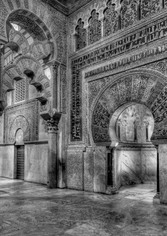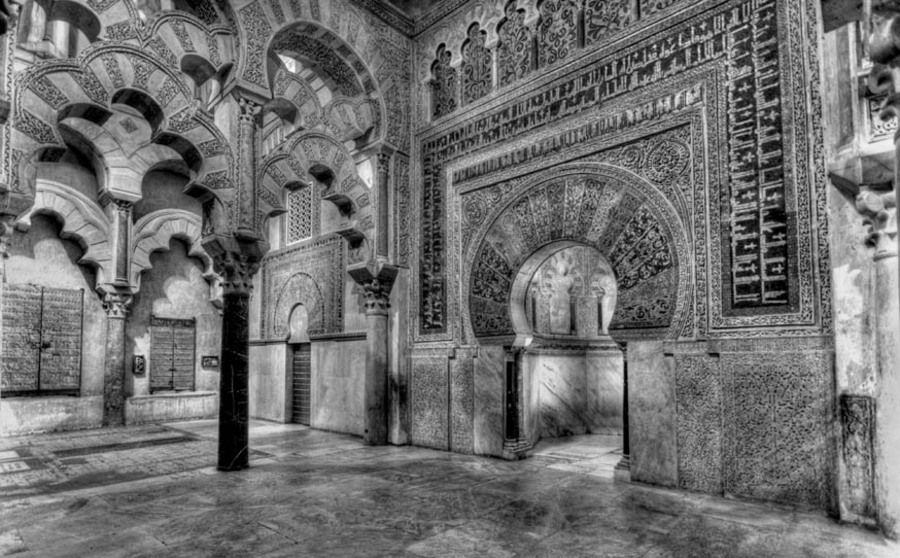Conferences and debates
Index / Activities / Conferences and debates / Series of conferences on the Aljama Mosque in Cordoba
Series of conferences on the Aljama Mosque in Cordoba
From October 21, 2014 until December 17, 20147.00 pm
CóRDOBA
Casa Árabe Auditorium (at Calle Samuel de los Santos Gener, 9 – Cordoba)
7.00 pm
Free entrance until the event’s capacity is reached
Three experts perform an in-depth analysis of the monument
Casa Árabe is dedicating a series of conferences to analyzing the artistic and architectural value of the largest construction from the Umayyad period on the Iberian Peninsula, a monument which also served to claim and consolidate the establishment of an independent caliphate. Through three conferences given by domestic and foreign experts, the parallels between Cordoba’s mosque and those in Damascus, Medina and Jerusalem will be studied. The unusual capitals on their columns will be analyzed, and study will be conducted on how its layout and space were used as political and religious symbols.
Conference series information sheet
-
 Foto: Vicente Castelló
Foto: Vicente CastellóCordoba’s Mosque and the legacy of the Umayyad caliphate of Damascus: Myths and realities
October 21, 20147:30 pmCóRDOBACasa Árabe Auditorium (at Calle Samuel de los Santos Gener, 9 – Cordoba) 7:30 pm Free entrance until the event’s capacity is reachedSusana Calvo Capilla, a professor of the Department of Art History I of the Universidad Complutense de Madrid, is offering this talkArab sources from Al-Andalus establish various analogies between the Mosque in Cordoba and the Umayyad Mosque in Damascus. Having been painstakingly analyzed, some of these analogies reveal common myths and stereotypes in the sources of Arab conquests (futūhāt). First of all, we will be examining their origins, because in both cases there are allusions to the conquerors’ creation of the first site for prayer in a space shared with Christians. Likewise, parallels are drawn between the Umayyads of Al-Andalus and their ancestors from the East in the construction of the first Aljama Mosque. Archeology has contributed to clarifying some of these allegorical aspects included in the texts. The myths are not limited to the periods of the conquest and emirate. During the era of the caliphs, the Umayyads of Al-Andalus once again turned to their ancestors to reclaim and consolidate their ascent to the caliphate, this time given form not only in texts, but also in the architecture, decoration and furnishings of the Cordoba Mosque’s expansion: the mosaics, the contents of its inscriptions, the scalloping in the mihrab, the Qur’an and the minbar provide interesting correspondences with Damascus, Medina and Jerusalem.Susana Calvo Capilla is a professor of the Department of Art History I (Medieval) of the Universidad Complutense de Madrid. She is the main researcher on the project “Al-Andalus, The Hispanic Kingdoms and Egypt: Art, power and knowledge in the Medieval Mediterranean. The networks of trade and their impact on visual culture” (HAR2013-45578-R), financed by Spain’s Ministry of the Economy and Competitiveness. She has completed stays at research centers in Damascus, Cairo and Aix-en-Provence. Her main line of research is Al-Andalus and its art, which she has studied within the context of Islam and medieval art. Her most notable publications have focused on study of the Cordoba Mosque and Umayyad visual culture, the mosques of Al-Andalus, and the process of their consecration after the Christian conquest. In her latest research works, she has discussed the topic of spaces for knowledge in the palaces of Al-Andalus, and more specifically at Madinat al-Zahra. -
 Foto: Vicente Castelló
Foto: Vicente CastellóThe Aljama Mosque of Cordoba and the use of capitals in Umayyad architecture: an ensemble overview
November 25, 20147:30 pmCóRDOBACasa Árabe Auditorium (at Calle Samuel de los Santos Gener, 9 – Cordoba) 7:30 pm Free entrance until the event’s capacity is reachedPatrice Cressier, of the Inter-university Center of History and Medieval Archeology of the CNRS, will be giving this talk.The Umayyad Aljama Mosque in Cordoba, as it has reached us in our era after being transformed into a Catholic cathedral, with the successive rebuilding which this entailed, is quite probably the largest museum of ancient column capitals in Europe. At this conference, we have set the objective of giving a brief presentation on these re-used Roman and Visigoth pieces of heritage, and last of all, of the first Islamic prototypes which arose during the expansion carried out by Abd al-Rahmân II in the year of 845.
We place an emphasis on the difficulties which are involved in studying the de-contextualization of most of these capitals, and above all we show that their layout in the building was not completely random, but instead served as a counterpoint for highlighting the hierarchical organization of the monument’s interior spaces. This leads us to ask questions about the reasons behind these peculiar architectural choices made by the architects of Al-Andalus and those with whom they worked.
Although it is an unusually spectacular case, the Aljama Mosque in Cordoba was not the only one of its kind during the earliest centuries of Islam to place such an important role on the capitals crowning columns. We will be seeing examples for comparison which will help us to understand Cordoba’s monument a bit better. Amongst those of greatest interest, we will take a closer look at the Qayrawân Mosque in Tunisia.
The advent of the caliphate led to the abandonment of using capitals and the standardization of the morphology of capitals, but the importance placed on this architectural element was maintained and even reinforced, probably controlling its production and state-run workshops. In conclusion, we briefly refer to these new practices and to these new uses on the basis of observations made at Madînat al-Zahrâ.
Patrice Cressier is a doctor of Geophysics (University of Strasbourg, 1980) and Islamic Art History and Archeology (University of Paris 4-Sorbonne, 1981). He was the director of studies for Antiquity and the Middle Ages at the Casa de Velázquez (Madrid) from 1995 to 2002. He is now a researcher (chargé de recherche) at the French Centre National de la Recherche Scientifique.
Mr. Cressier has been a member of the technical commission on the Alcazaba in Almería for several years and is a member of the scientific committee or editorial board for over ten scientific journals in France and Spain.
He is the author of approximately twenty books and numerous articles. His research has dealt with topics involving the rural population and territorial organization in Al-Andalus (more specifically, in the modern-day provinces of Granada and Almería), on irrigated landscapes and rural hydraulics, as well as the genesis of the Islamic city in the Western Maghreb, where he has led several archeological research programs in Morocco and Tunisia (excavations of the Fatimid caliph’s capital at Sabra al-Mansûriya). For the last three years, he has been taking part in a project which focuses on the barren city of Sedrata in Algeria.
In Spain, he has participated in several research, development and innovation programs involving the caliphate capital of Madînat al-Zahrâ’. He currently forms part of the project led by D. E. Manzano (CSIC), “Fatimids and Umayyads: The struggle of the caliphates in the Maghreb and its effects on Al-Andalus.” His relationship with the Umayyad Mosque of Cordoba is long-lasting and goes back to the late 1970’s, when he studied the capitals in this famous building. The results of this research were published in Madrider Mitteilungen, a journal published by the German Archeological Institute. Later, Islamic capitals and the use which the architects of Al-Andalus and the Maghreb made of them continued to interest him enough to inspire him to publish more than thirty articles on the topic.
-
 Foto: Vicente Castelló
Foto: Vicente CastellóSpace and identity in Islam. Case study of the Cordoba Mosque
December 17, 20147:30 pmCóRDOBACasa Árabe Auditorium (at Calle Samuel de los Santos Gener, 9 – Cordoba) 7:30 pm Free entrance until the event’s capacity is reachedMónica Rius, a professor of the Department of Arab and Islamic Studies at the University of BarcelonaMost are well aware that mosques must be oriented towards Mecca, but to what extent was this requirement actually adhered to? And to what length was it even necessary and possible to do so? These topics are the focus of a conference at which we will also be analyzing the use of mosques as a political, religious, aesthetic and spatial symbol.
From the very first mosque built by Mohammed in the city of Medina to the present time, the qibla has been a symbol of the Islamic community’s unity. Spatially, this unit took the form of the convergence of everyone’s sight, of all bodies facing towards the same point, the Kaaba in Mecca. Because of this, the qibla has undergone study by numerous specialists in various arenas: legal experts, astronomers, historians… Within the richness of nuances that characterize the history of Islam, there has been a wide range of opinions, which have occasionally flared up into heated debates.
The Aljama Mosque of Cordoba, being the most important in the Islamic West, was the center of attention for scholars from Al-Andalus, who had already observed from early times that it was not oriented towards Mecca. However, the reasons for its orientation remain within the realm of hypothesis.
At the same time, although the orientation of buildings is currently a problem which is easy to deal with, the symbolism which is created by each new construction is obvious and comes to occupy a notable place with the collective imagery of a globalized world.
Mónica Rius has been a professor in the Department of Arab and Islamic Studies at the University of Barcelona since 1998. She received her doctorate at that university in 1999. Her research has focused on the history of Arab science, and more specifically on popular astronomy in Al-Andalus and the Maghreb, the social history of science and medicine, and contemporary Arab literature. She has studied the construction of new identities in Spain through the work of Catalonian authors of Moroccan origin. At the same time, she has studied the orientation of mosques in Al-Andalus and North Africa, as well as the role of scientists in the Umayyad court of Al-Andalus. She has published numerous articles in scientific journals and books and has given many conferences. She has been the president of the Catalan Science and Technology History Society (SCHCT) and the secretary of the Spanish Arab Studies Society (SEEA). She is the coordinator of the European Master’s degree program in Construction and Representation of Cultural Identities and the director of the Master’s degree program in the Arab and Islamic World, both at the University of Barcelona. She is the main researcher in the research project titled "Construction of Identities, Gender and Artistic Creation," (FFI2011-26896), financed by Spain’s Ministry of the Economy and Competitiveness.
Some of her publications are available online at the website academia.edu: https://ub.academia.edu/MonicaRius.
twitter: @monica_rius

